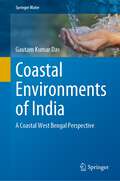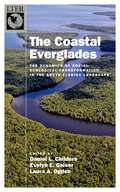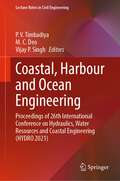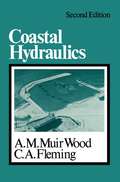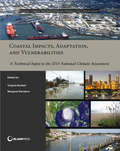- Table View
- List View
Coastal Environments: Focus on Asian Coastal Regions
by V. SubramanianThis book deals with the major issues being faced by the coastal population in Asia with emphasis on natural and man-made hazards, climate change impact and pressures caused by mega cities along Asian coasts. The edited book contains chapters authored by experts who are well known in their own fields of specialization relevant to coastal processes. Emphasis has been given to almost all regions of Aisan coast although coverage for south and south eastern regions of Asia is rather strong. Each chapter has been peer reviewed and revised before acceptance. In this book practical suggestions to mitigate problems in sustainable management of coastal regions are also discussed. The book will be useful for students, researchers in physical and social science, policy makers and climate change specialists.
Coastal Environments of India: A Coastal West Bengal Perspective (Springer Water)
by Gautam Kumar DasThis book is the result of comprehensive research work on the various aspects of the West Bengal coast including the world’s largest riverine delta system, the Ganga-Brahmaputra Delta. The role of various hydrodynamic factors in shaping the coastal configuration and physicochemical parameters of coastal waters, soils, and granulometry of beach sands are extensively discussed. The coasts of the Indian peninsula, particularly the east coast, are subjected to severe cyclones, tidal bores, storm surges, and strong drift, which changes the coastal configuration as well as the quality of waters and the fertility of soils. A systematic description of major cyclones and their effects on coastal areas are described in detail. The book offers comprehensive information on the prevailing ecological conditions and lush green mangrove forests with wide-ranging flora and fauna of Sundarbans. UNESCO has declared Sundarbans as one of the world’s heritage sites, and as in other parts of the world, some of the coastal areas in West Bengal have attracted the attention of many tourists. Various steps undertaken by the government for coastal zone management and sustainable development of the coastal areas have been highlighted in the book. This book will be of interest to students and researchers of the coastal environment.
Coastal Erosion and Protection in Europe: A Comprehensive Overview
by Enzo Pranzini Allan WilliamsEurope has a long history of managing coastal erosion through a variety of protection strategies, from the defences of the Venice lagoons to coastal land reclamation in the Netherlands. This book provides a comprehensive review of the entire coastline of Europe and a comparative analysis of erosion problems and solutions in each country. Each chapter discusses the natural and anthropogenic factors in the erosion process and in defence projects design and maintenance, including coastal morphology and wave climate, land use changes and use of coastal areas, the evolution of coastal protection, climate change and political and administrative assessments. Particular attention is paid to demographic and economic factors influencing coastal erosion in each country and to technical and administrative criteria influencing defence projects design. Lavishly illustrated in full colour throughout, the book represents a definitive reference work on its subject.
Coastal Erosion and Protection in Europe
by Enzo Pranzini Allan WilliamsEurope has a long history of managing coastal erosion through a variety of protection strategies, from the defences of the Venice lagoons to coastal land reclamation in the Netherlands. This book provides a comprehensive review of the entire coastline of Europe and a comparative analysis of erosion problems and solutions in each country. Each chapter discusses the natural and anthropogenic factors in the erosion process and in defence projects design and maintenance, including coastal morphology and wave climate, land use changes and use of coastal areas, the evolution of coastal protection, climate change and political and administrative assessments. Particular attention is paid to demographic and economic factors influencing coastal erosion in each country and to technical and administrative criteria influencing defence projects design. Lavishly illustrated in full colour throughout, the book represents a definitive reference work on its subject.
The Coastal Everglades: The Dynamics of Social-Ecological Transformation in the South Florida Landscape (The Long-Term Ecological Research Network Series)
by Daniel L. Childers, Evelyn E. Gaiser, and Laura A. OgdenThe Coastal Everglades presents a broad overview and synthesis of research on the coastal Everglades, a region that includes Everglades National Park, adjacent managed wetlands, and agricultural and urbanizing communities. Contributors for this volume are all collaborators on the Florida Coastal Everglades Long-Term Ecological Research Program (FCE LTER). The FCE LTER began in 2000 with a focus on understanding key ecosystem processes in the coastal Everglades, while also developing a platform for and linkages to related work conducted by an active and diverse Everglades research community. The program is based at Florida International University in Miami, but includes scientists and students from numerous other universities as well as staff scientists at key resource management agencies, including Everglades National Park and the South Florida Water Management District. Though the Everglades landscape spans nearly a third of the State of Florida, the focus on the coastal Everglades has allowed the contributors to examine key questions in social-ecological science in the context of ongoing restoration initiatives. As this book demonstrates, the long-term research of the FCE LTER has facilitated a better understanding of the roles of sea level rise, water management practices, urban and agricultural development, and other disturbances, such as fires and storms, on the past and future dynamics of this unique coastal environment. By comparing properties of the Everglades with other subtropical and tropical wetlands, the book challenges ideas of novelty while revealing properties of ecosystems at the ends of gradients that are often ignored. It also provides insights from, and encouragement for, long-term collaborative studies that inform resource management in similarly threatened coastal wetland landscapes.
The Coastal Everglades: The Dynamics of Social-Ecological Transformation in the South Florida Landscape (The Long-Term Ecological Research Network Series)
The Coastal Everglades presents a broad overview and synthesis of research on the coastal Everglades, a region that includes Everglades National Park, adjacent managed wetlands, and agricultural and urbanizing communities. Contributors for this volume are all collaborators on the Florida Coastal Everglades Long-Term Ecological Research Program (FCE LTER). The FCE LTER began in 2000 with a focus on understanding key ecosystem processes in the coastal Everglades, while also developing a platform for and linkages to related work conducted by an active and diverse Everglades research community. The program is based at Florida International University in Miami, but includes scientists and students from numerous other universities as well as staff scientists at key resource management agencies, including Everglades National Park and the South Florida Water Management District. Though the Everglades landscape spans nearly a third of the State of Florida, the focus on the coastal Everglades has allowed the contributors to examine key questions in social-ecological science in the context of ongoing restoration initiatives. As this book demonstrates, the long-term research of the FCE LTER has facilitated a better understanding of the roles of sea level rise, water management practices, urban and agricultural development, and other disturbances, such as fires and storms, on the past and future dynamics of this unique coastal environment. By comparing properties of the Everglades with other subtropical and tropical wetlands, the book challenges ideas of novelty while revealing properties of ecosystems at the ends of gradients that are often ignored. It also provides insights from, and encouragement for, long-term collaborative studies that inform resource management in similarly threatened coastal wetland landscapes.
Coastal Fluxes in the Anthropocene: The Land-Ocean Interactions in the Coastal Zone Project of the International Geosphere-Biosphere Programme (Global Change - The IGBP Series)
by Christopher J. Crossland Hartwig H. Kremer Han J. Lindeboom Janet I. Marshall Crossland Martin D. A. Le TissierThis book synthesizes knowledge of coastal and riverine material fluxes, biogeochemical processes and indications of change, both natural, and increasingly human-initiated. Here, the authors assess coastal flux in the past and present, and in future under the International Geosphere-Biosphere Programme (IGBP), the International Human Dimensions Programme on Global Environmental Change (IHDP) and the LOICZ II (Land-Ocean Interactions in the Coastal Zone) Project.
Coastal Geology (Springer Textbooks in Earth Sciences, Geography and Environment)
by Juan A. MoralesThis textbook shows all the existing knowledge about coastal geology and its implications for coastal management. In the last decades, the geological sciences have been supplying exciting information about the coastal systems, not only from its dynamics but also providing a sedimentary concept to understand and interpret the preserved coastal stratigraphical record. Furthermore, recent investigations have been focused on the prevention of coastal hazards like storms, tsunamis, or sea-level fluctuation. This discipline has an increasing interest after the expanding human activities around the coasts worldwide. The present trend is that many of the problems raised by the coast–human interaction must be resolved by using the Integrated Coastal Zone Management.The chapters of this book have a double-level structure. The first part of each chapter contains the necessary information for undergraduate courses studying coastal geology. The second part includes advanced information and examples to be used by graduate students and novel professionals.
Coastal Geomorphology: An Introduction
by Eric C. BirdCoastal Geomorphology, Second Edition is a comprehensive and systematic introduction to this subject and demonstrates the dynamic nature of coastal landforms, providing a background for analytical planning and management strategies in coastal areas that are subject to continuing changes. This introductory textbook has been completely revised and updated, and is accompanied by a website which provides additional illustrations, global examples, case-studies and more detailed and advanced information on topics referenced in the book, together with explanations of terminology, annotated references and research material.
Coastal Geomorphology: An Introduction
by Eric C. BirdCoastal Geomorphology, Second Edition is a comprehensive and systematic introduction to this subject and demonstrates the dynamic nature of coastal landforms, providing a background for analytical planning and management strategies in coastal areas that are subject to continuing changes. This introductory textbook has been completely revised and updated, and is accompanied by a website which provides additional illustrations, global examples, case-studies and more detailed and advanced information on topics referenced in the book, together with explanations of terminology, annotated references and research material.
Coastal Governance (Foundations of Contemporary Environmental Studies)
by Richard BurroughsCoastal Governance provides a clear overview of how U.S. coasts are currently managed and explores new approaches that could make our shores healthier. Drawing on recent national assessments, Professor Richard Burroughs explains why traditional management techniques have ultimately proved inadequate, leading to polluted waters, declining fisheries, and damaged habitat. He then introduces students to governance frameworks that seek to address these shortcomings by considering natural and human systems holistically. The book familiarizes students not only with current management techniques but with the policy process. By focusing on policy development, Coastal Governance prepares readers with the knowledge to participate eff ectively in a governance system that is constantly evolving. This understanding will be critical as students become managers, policymakers, and citizens who shape the future of the coasts.
Coastal, Harbour and Ocean Engineering: Proceedings of 26th International Conference on Hydraulics, Water Resources and Coastal Engineering (HYDRO 2021) (Lecture Notes in Civil Engineering #321)
by P. V. Timbadiya M. C. Deo Vijay P. SinghThis book comprises the proceedings of the 26th International Conference on Hydraulics, Water Resources and Coastal Engineering (HYDRO 2021) focusing on broad spectrum of emerging opportunities and challenges in the field of coastal, harbor and ocean engineering. It covers a range of topics, including, but not limited to, coastal disasters including tsunamis, cyclones and storm surges, sea level rise, coastal structures and oceanography, wave-structure interaction, etc. Presenting recent advances in the form of illustrations, tables, and text, it offers readers insights for their own research. In addition, the book addresses fundamental concepts and studies in the field of coastal, harbor and ocean engineering, making it a valuable resource for both beginners and researchers wanting to further their understanding of hydraulics, water resources and coastal engineering.
Coastal Hazards (Coastal Research Library #6)
by Charles W. FinklThis book covers the gamut of coastal hazards that result from short-term low-frequency events and have high-magnitude and far-reaching impacts on coastal zones the world over. Much of the world’s population now lives in low-lying coastal zones that are inherently vulnerable to natural hazards such as flooding from hurricanes, tropical storms and northeastern storm surges; shoreline (beach and dune) erosion; cliff and bluff failures; and saltwater intrusion in coastal aquifers used for drinking water supplies. In addition to the usual range of hydrometeorological disasters in coastal zones, this book covers tsunami impacts and warning systems as well as global perspectives of sea-level rise impacts and human perceptions of potential vulnerabilities resulting from rip currents that cause many drownings each year on beaches. Today, the use of numerical models that help predict vulnerabilities and provide a basis for shore protection measures is important in modern scientific and engineering systems. Final considerations focus on human actions in the form of the urbanization and industrialization of the coast, shore protection measures, and indicate how environmental degradation around coastal conurbations exacerbates the potential for unwanted impacts. Strategies for environmental management in coastal zones, from low-lying wetlands to high cliffs and rocky promontories, are highlighted as a means of living in harmony with Nature and not trying to conquer it.
Coastal Heritage and Cultural Resilience (Ethnobiology)
by Nemer E. Narchi Lisa L. PriceThis book explores the knowledge, work and life of Pacific coastal populations from the Pacific Northwest to Panama. Center stage in this volume is the knowledge people acquire on coastal and marine ecosystems. Material and aesthetic benefits from interacting with the environment contribute to the ongoing building of coastal cultures. The contributors are particularly interested in how local knowledge -either recently generated or transmitted along generations- interfaces with science, conservation, policy and artistic expression. Their observations exhibit a wide array of outcomes ranging from resource and human exploitation to the magnification of cultural resilience and coastal heritage. The interdisciplinary nature of ethnobiology allows the chapter authors to have a broad range of freedom when examining their subject matter. They build a multifaceted understanding of coastal heritage through the different lenses offered by the humanities, social sciences, oceanography, fisheries and conservation science and, not surprisingly, the arts. Coastal Heritage and Cultural Resilience establishes an intimate bond between coastal communities and the audience in a time when resilience of coastal life needs to be celebrated and fortified.
Coastal Impacts, Adaptation, and Vulnerabilities: A Technical Input to the 2013 National Climate Assessment (NCA Regional Input Reports)
by Virginia Burkett and Margaret DavidsonDeveloped to inform the 2013 National Climate Assessment, this report examines the known effects and relationships of climate change variables on the coasts of the US. It describes the impacts on natural and human systems, including several major sectors of the US economy, and covers the progress and challenges to planning and implementing adaptation options.
Coastal Karst Landforms (Coastal Research Library #5)
by Michael J. Lace and John E. MylroieCarbonate rock coasts are found world-wide, from continental shorelines of the Adriatic Sea of Europe to the Yucatan Peninsula of North America, and on tropical islands from Rodrigues Island in the Indian Ocean, to the Mariana Islands in the Pacific Ocean, to the Bahama Islands in the Atlantic Ocean. Such coasts are well known for their unusual and distinctive karst landforms. Karst processes, particularly those associated with coastal landforms, are proving to be surprisingly unique and complex. This volume presents a comprehensive overview of the processes associated with coastal karst development comparing examples from a broad geographical and geomorphological range of island and continental shoreline/paleoshoreline settings, including a review of pseudokarst processes that can compete with and overprint dynamic coastal karst landscapes. As effective management of hydrologic resources grows more complex, coastal caves and karst represent fundamental components in associated coastal aquifers, which in the rock record can also form significant petroleum reservoirs. Audience By providing a clearer understanding of the geological, biological, archaeological and cultural value of coastal caves and karst resources, this volume offers a critical tool to coastal researchers and geoscientists in related fields and to coastal land managers as it illustrates the diversity of coastal karst landforms, the unique processes which formed them, the diversity of resources they harbor and their relationship to coastal zone preservation strategies and the development of sustainable management approaches.
Coastal Lagoon Eutrophication and ANaerobic Processes: Nitrogen and Sulfur Cycles and Population Dynamics in Coastal Lagoons A Research Programme of the Environment Programme of the EC (DG XII) (Developments in Hydrobiology #117)
by Pierre Caumette Jacques Castel Rodney HerbertThis multidisciplinary volume comprehensively reviews our current knowledge of the effects of urban, industrial and agricultural pollution on the biology of shallow coastal marine lagoons. All the authors are internationally recognized authorities and have had many years of experience in their respective fields. The major strength of this volume is that it integrates several fields of research including biogeochemistry, marine microbiology, marine algology and marine zoology. By adopting such a strategy the reader is provided with a clear insight of the key processes involved in lagoon eutrophication and dystrophy and their impact on the different biological communities which live in such environments. This book will therefore provide an essential reference work for environmental biologists, ecologists, microbiologists and those involved in the management and commercial exploitation of these economically important ecosystems.
Coastal Lowlands: Geology and Geotechnology
by W. J. M. van der Linden S. A. P. L. Cloetingh J. P. K. Kaasschieter W. J. E. van de Graaff J. Vandenberghe J. A. M. van der GunCoastal Lowlands by virtue of their position across the boundary of land and sea belong to the earth's most dynamic systems. This is true in the physical, i. e. geological and biological, as much as in the cultural and social sense. Although the nearness to the sea was and still is fraught with danger coastal lowlands have always attracted human interest, providing challenging opportunity, holding the promise of profitable enterprise. Coastal lowlands, especially where rivers enter the region, are the cradles of great civilisations and there, of old, populations reached highest densities. As an example, Dutch history is a tale of human struggle and endeavour with and against the sea. Dutch 'low landers' wrestled their land from the sea, in turn the sea forged a nation of independent fishermen, navigators, farmers and traders who built their towns and ships at the borders of the North and Zuyder Seas. As lowlands subside and sea level rises, apparently these days at an increasing rate, concern about this environment world-wide is also rising. It certainly was appropriate and timely for the Royal Geological and Mining Society of the Netherlands when celebrating its 75th birthday to organize and call together a symposium, focussing attention on the geology and geotechnology of coastal lowlands; geology to better understand their formation and evolution, geotechnology to better manage and harvest resources as much as protect a unique and crucial environment.
Coastal Marine Ecosystems of Latin America (Ecological Studies #144)
by U. Seeliger B. KjerfveCoastal and marine ecosystems, some severely degraded, other still pristine, control rich resources of inshore environments and coastal seas of Latin America's Pacific and Atlantic margins. Conflicts between the needs of the region's nations and diminishing revenues and environmental quality have induced awareness of coastal ecological problems and motivated financial support for restoration and management.The volume provides a competent review on the structure, processes and function of 22 important Latin American coastal marine ecosystems. Each contribution describes the environmental settings, biotic components and structure of the system, considers trophic processes and energy flow, evaluates the modifying influence of natural and human perturbations, and suggests management needs. Although the focus of the book is on basic ecological research, the results have application for coastal managers.
Coastal Morphodynamics: Integrated Spatial Modeling on the Deltaic Balasore Coast, India (SpringerBriefs in Geography)
by Nilay Kanti Barman Soumendu Chatterjee Ashis Kumar PaulThis book discusses the perceptions and sketches, geological background, materials and coastal processes of the East Coast of India. It also suggests strategies for effectively managing natural coastal processes in these areas. India has a coastline of about 7,516 km with a variety of coastal extensions, which developed at different time scales, producing permanent variations in the morphologies of the coastal areas through hydrodynamic, fluvial, aeolian and terrestrial processes. The book focuses on the Balasore coast, an area drained by three main rivers (the Subarnarekha, the Dugdeugi and the Burahbolong), which impacts the coastal morphodynamic processes of the area and accounts for their multifaceted nature.Large drops or increases in the sediment supply within a short time span or over prolonged periods cause shoreline shifting. Eight satellite images from 1975, 1980, 1990, 1995, 2000, 2005, 2010 and 2013 were used to measure the shoreline dynamics, and a reference line was established using first order polynomial model with base data with 0.5 pixel root mean square error (RMSE) accuracy. The end point rate (EPR) model was adopted for estimating the future position of the shoreline. In order to assess the beach morphodynamics, the coastal modeling system (SMC) was used, which incorporates with a series of appliances and numerical models structured consistent with the space and time scale of the different dynamics affecting the littoral and beach morphology based on diverse thematic and reference documents. This study employed short-term analysis using the MOPLA module of the SMC system, which consists of three attached modules: the wave transformation module (Oluca), the depth-averaged currents module (Copla) and the sediment transport and morphological evolution module (Eros).The shoreline dynamics findings show that the magnitude of erosion is higher in the northern part of the coastline in the left bank area of the Subarnarekha river estuary and in the estuarine part of the Dugdugi and Burahbalang rivers. The southern part of the shoreline near Rasalpur and Joydevkasba is relatively stable, and the study suggests that the current shoreline shift trend will continue in the future. The SMC model indicates that the wave height, significant wave height, current velocity and the potential transport of sediment at the Kirtaniya study point are high, while at Choumukh they are low and at the Rasalpur study point they are intermediate.
Coastal Ocean Observing: Platforms, Sensors and Systems
by Jorge E. CorredorThis manual describes the wide range of electromechanical, electrochemical and electro-optical transducers at the heart of current field-deployable ocean observing instruments. Their modes of operation, precision and accuracy are discussed in detail. Observing platforms ranging from the traditional to the most recently developed are described, as are the challenges of integrating instrument suits to individual platforms. Technical approaches are discussed to address environmental constraints on instrument and platform operation such as power sources, corrosion, biofouling and mechanical abrasion. Particular attention is also given to data generated by the networks of observing platforms that are typically integrated into value-added data visualization products, including numerical simulations or models. Readers will learn about acceptable data formats and representative model products. The last section of the book is devoted to the challenges of planning, deploying and maintaining coastal ocean observing systems. Readers will discover practical applications of ocean observations in diverse fields including natural resource conservation, commerce and recreation, safety and security, and climate change resiliency and adaptation. This volume will appeal to ocean engineers, oceanographers, commercial and recreational ocean data users, observing systems operators, and advanced undergraduate and graduate students in the field of ocean observing.
Coastal-Offshore Ecosystem Interactions: Proceedings of a Symposium sponsored by SCOR, UNESCO, San Francisco Society, California Sea Grant Program, and U.S. Dept. of Interior, Mineral Management Service held at San Francisco State University, Tiburon, California, April 7–22, 1986 (Coastal and Estuarine Studies #22)
by Bengt-Owe Janssonstable isotope ratios act as naturally-occurring tracers for organic matter, making possible, under certain conditions, the quantification of coastal-offshore exchanges. In general, organic matter has isotope ratios characteristic of its origin (e. g. plants with different modes of photosynthesis and different growth conditions, anthropogenic compounds). These ratios are maintained as the organic matter moves through the biosphere and geosphere. A mixture of organic matter from two sources has isotope ratios intermediate between those of the two sources, in proportion to the fraction of material from each source. Isotope ratios are one of the few methods which can trace organic matter as it moves through natural ecosystems. Ratios can be measured on both the total organic matter and on particular chemical fractions or compounds. When used on organisms, isotope ratios provide information of organic matter actually assimilated into body tissues, not just material ingested. As with all tools, this method has certain limitations which must be borne in mind when interpreting its results. Firstly, specific environmental conditions must be met. This generally means an ecosystem with a limited and known number of sources of organic matter having different isotope ratios. Two sources with different isotope ratios are ideal; additional sources with other isotope ratios complicate interpretation. Secondly, the difference in isotope ratios of the two sources should be large compared with analytical variability. Thirdly, the ratios within each source should vary as little as possible.
Coastal Problems: Geomorphology, Ecology and Society at the Coast
by Heather Viles Tom SpencerAs coastal populations burgeon, problems of erosion, pollution and coastal change are becoming ever more serious and necessitate scientifically informed management strategies. This authoritative new study discusses the causes of, and possible solutions to, some of the more pressing problems at the coast, against a background of the natural geomorphological and ecological workings of coastal environments.A holistic approach to the understanding of coastal problems is suggested, which integrates geomorphology, ecology and society through a consideration of the basic processes at work. Coastal problems are caused by both human and natural impacts, often working in conjunction with each other; thus drawing on their wide experience of temperate and tropical coasts the authors consider all types of coastal problems, ranging from those produced entirely naturally to those where the human impact dominates. Extensive use is made of case studies drawn from around the world, from beach erosion along the Nigerian coast to the recovery of the Vietnamese mangroves from war damage. A major theme of the book is that, given recent downgrading of predictions of future sea level rise, it is the distinctive geomorphological, ecological and societal aspects of each coast which are the vital factors.'Coastal Problems' brings together material vital to any attempts to understand and manage our coasts and will be of interest to all those concerned with the environment and its management.

